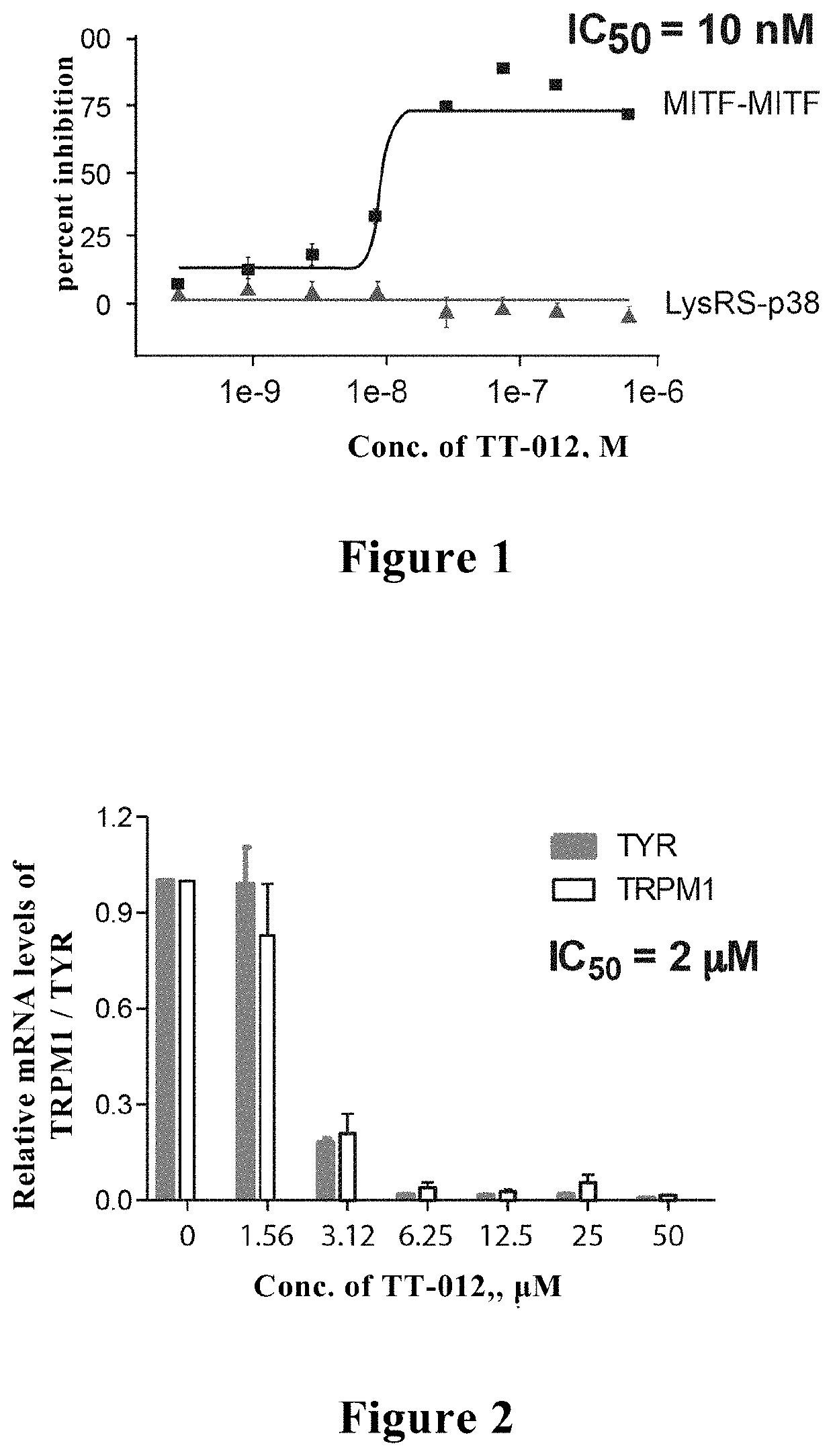Use of aromatic ring drug in inhibiting key transcription factor of malignant melanoma
a transcription factor and aromatic ring technology, applied in the field of medicinal chemistry, can solve the problems of reducing drug resistance, reducing drug resistance, and reducing drug resistance, and determining whether mitf can be specifically and effectively targeted by small molecule compounds, and achieving the effect of specific targeting of small molecule probes
- Summary
- Abstract
- Description
- Claims
- Application Information
AI Technical Summary
Benefits of technology
Problems solved by technology
Method used
Image
Examples
example 1
[0085]TT-012 Effectively and Specifically Inhibited Formation of MITF Dimer.
[0086]In the AlphaScreen high-throughput screening model MIDAS (MITF Dependent Alpha-Screen), MITF was labeled with a Biotin tag recognized by Alpha donor beads and a His tag recognized by Alpha receptor beads, respectively. When MITF formed a dimer, Alpha Donor beads and Alpha Receptor beads were pulled close to each other and detected by 680 nM excitation light and 520-620 nM emission light, thereby monitoring the formation of MITF dimer. With MIDAS technology, TT-012 could efficiently inhibit formation of MITF dimer with IC50=10 nM (see FIG. 1). FIG. 1 showed that, TT-012 could effectively inhibit formation of MITF dimer with IC50=10 nM ((labeled by square) through the high-throughput screening model MIDAS (MITF Dependent Alpha-Screen) test, while not affect the AlphaScreen signal of LysRS-p38 interaction in the control test (labeled by triangle).
example 2
[0087]TT-012 Specifically Inhibited the Transcriptional Activity of MITF
[0088]TT-012 was incubated with melanoma cell B16F10 cell line, mRNA was extracted and reverse transcripted, and the transcription of MITF landmark downstream genes-TYR (tyrosinase) and TRPM1 (transient receptor potential cation channel M1) were detected by fluorescent quantitative PCR. TT-012 could effectively inhibit the mRNA levels of MITF landmark downstream genes-TYR and TRPM1 with IC50=2 μM through RT-PCR experiments. FIG. 2 showed that active TT-012 could significantly inhibit the transcription of genes downstream to MITF.
example 3
[0089]TT-012 Specifically Inhibited the Growth of Malignant Melanoma
[0090]The active TT012 was incubated with MITF-dependent and highly expressed melanoma cell line B16F10, the melanoma cell line A375 with low expression of MITF, and control cell line Hela, respectively, and cell activity was detected by MTT experiment. As could be seen from FIG. 3, TT-012 could effectively inhibit the growth of MITF-dependent malignant melanoma cells B16F10 with IC50=300 nM (labeled by square), but have no killing effects on the melanoma cell line A375 with low expression of MITF (labeled by circle) and control cells HELA (labeled by triangle), suggesting that TT-012 could specifically inhibit MITF activity and inhibit the growth of MITF-dependent malignant melanoma.
PUM
| Property | Measurement | Unit |
|---|---|---|
| structure | aaaaa | aaaaa |
| resistance | aaaaa | aaaaa |
| drug resistance | aaaaa | aaaaa |
Abstract
Description
Claims
Application Information
 Login to View More
Login to View More - R&D
- Intellectual Property
- Life Sciences
- Materials
- Tech Scout
- Unparalleled Data Quality
- Higher Quality Content
- 60% Fewer Hallucinations
Browse by: Latest US Patents, China's latest patents, Technical Efficacy Thesaurus, Application Domain, Technology Topic, Popular Technical Reports.
© 2025 PatSnap. All rights reserved.Legal|Privacy policy|Modern Slavery Act Transparency Statement|Sitemap|About US| Contact US: help@patsnap.com



